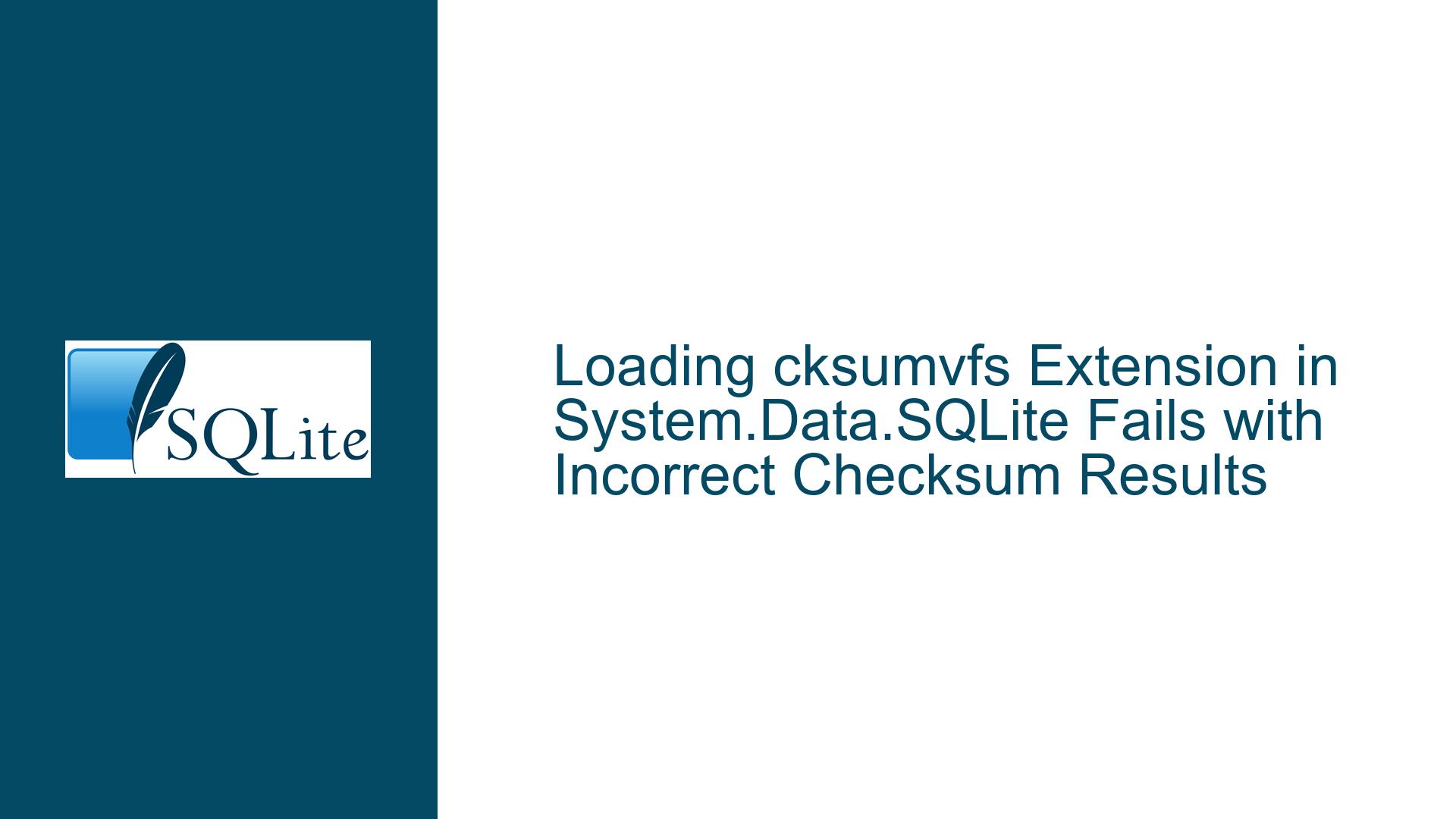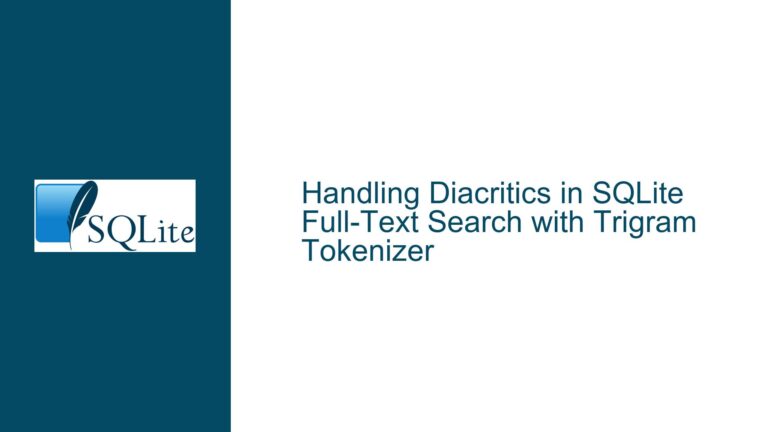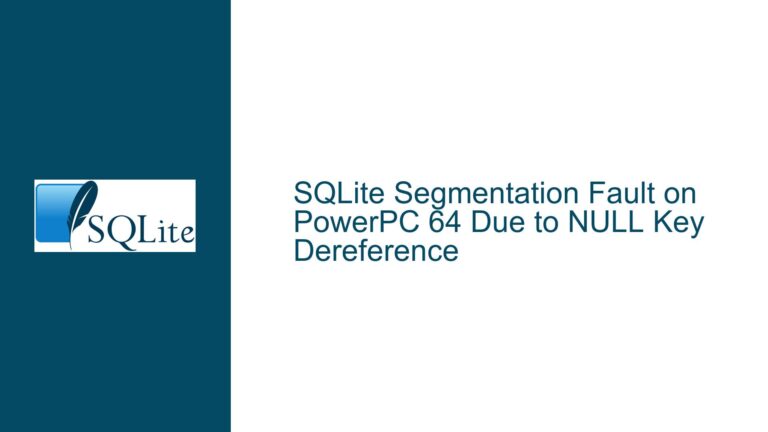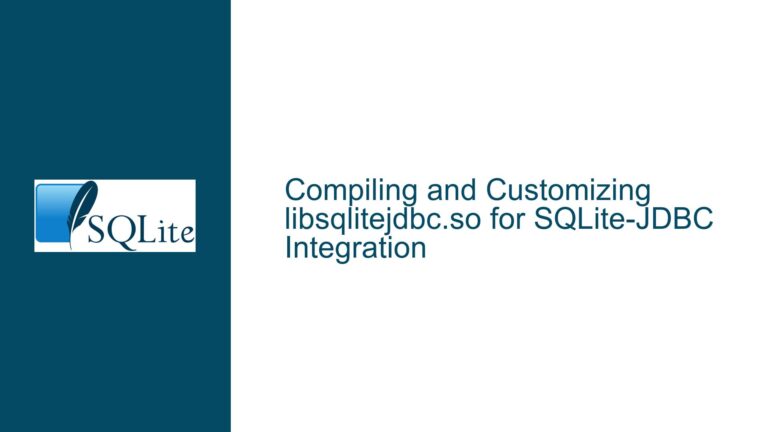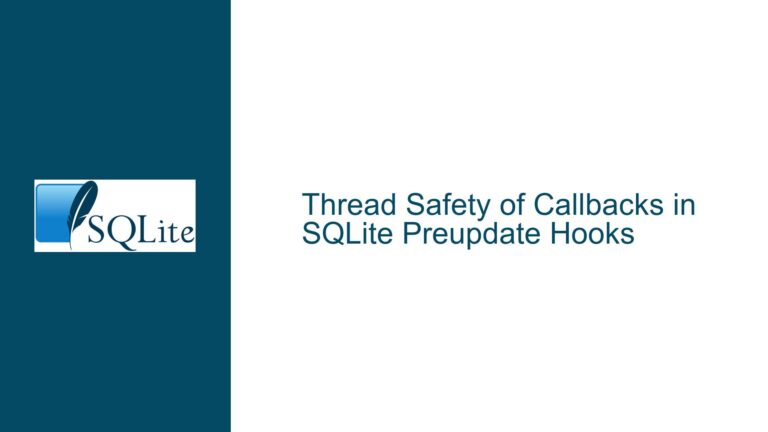Loading cksumvfs Extension in System.Data.SQLite Fails with Incorrect Checksum Results
Issue Overview: Extension Loading Sequence and Checksum Validation Misconfiguration
The core issue revolves around the improper initialization of the SQLite cksumvfs extension within the System.Data.SQLite library, leading to persistent verify_checksum function failures (always returning 0) and inability to activate checksum verification via PRAGMA checksum_verification. The problem is not inherently due to System.Data.SQLite lacking extension support but stems from a misunderstanding of the load order, connection lifecycle management, and VFS (Virtual File System) initialization requirements specific to the cksumvfs extension.
The cksumvfs extension modifies SQLite’s low-level file I/O operations to compute and validate checksums on database pages. For this to function, the extension must be loaded before the target database connections are opened, using a dedicated dummy connection that is immediately closed after loading. The user’s code attempts to load the extension and perform checksum validation on the same connection, violating the extension’s initialization protocol. Furthermore, the absence of checksum data in pre-existing databases (not initialized with the cksumvfs VFS) results in validation failures, compounding the confusion.
Possible Causes: Connection Lifecycle, VFS Initialization, and Database Configuration
1. Incorrect Connection Lifecycle Management for VFS Activation
The cksumvfs documentation explicitly states that the extension must be loaded via a temporary dummy connection that is promptly closed. Subsequent connections opened after this process inherit the VFS. In the provided code, the same connection used to load the extension is reused for data operations. This violates the requirement that the VFS must be active before the operational connection is established. The dummy connection’s sole purpose is to load the extension; it cannot be used for normal database operations.
2. Missing or Incorrect Reserve Bytes Configuration
The cksumvfs extension requires the database to reserve 8 bytes per page for checksum storage. This is configured using PRAGMA schema.reserve_bytes=8. However, this setting only affects new databases or those explicitly rebuilt using the VACUUM command. If the database existed prior to configuring reserve_bytes, the checksum fields are absent, causing verify_checksum to return 0 (invalid checksum). The user might have applied this pragma to an existing database without rebuilding it, leading to a false assumption that checksums are being stored.
3. Extension Loading Sequence and Platform-Specific DLL Handling
System.Data.SQLite’s LoadExtension method requires the full path to the extension DLL unless the file is located in the system’s DLL search path. Specifying "cksumvfs.dll" without a path may fail if the runtime cannot locate the file. Additionally, enabling extensions via connection.EnableExtensions(true) might require elevated permissions or configuration overrides, depending on the host environment (e.g., .NET Core’s security policies).
4. Misinterpretation of Checksum Verification Workflow
The verify_checksum function and PRAGMA checksum_verification only return 1 if the checksum stored in the reserved bytes matches the computed value at the time of page access. If the database was modified without the cksumvfs VFS active (e.g., before the extension was loaded), the checksum fields are either missing or outdated. This leads to consistent 0 results, even if the extension is loaded correctly in subsequent connections.
Troubleshooting Steps: Validating Extension Loading, Rebuilding Databases, and Isolating VFS Dependencies
Step 1: Validate Extension Loading with Diagnostic Queries
Before invoking checksum-related functions, confirm that the extension is loaded and the cksumvfs VFS is active:
using var dummyConnection = new SQLiteConnection("Data Source=:memory:;");
dummyConnection.Open();
dummyConnection.EnableExtensions(true);
dummyConnection.LoadExtension("cksumvfs.dll"); // Use full path if necessary
dummyConnection.Close(); // Critical: Close dummy connection
// Open new connection for operations
using var operationalConnection = new SQLiteConnection(GetConnectionString());
operationalConnection.Open();
// Check available VFSes
using var cmd = new SQLiteCommand("PRAGMA vfs_list;", operationalConnection);
using var reader = cmd.ExecuteReader();
while (reader.Read())
{
Console.WriteLine($"VFS Name: {reader.GetString(0)}"); // Look for 'cksumvfs'
}
If cksumvfs does not appear in the VFS list, the extension failed to load. Common causes include incorrect DLL paths, permission issues, or mismatched architecture (e.g., loading a 32-bit DLL in a 64-bit process).
Step 2: Reconfigure Reserve Bytes and Rebuild Database
For checksums to be stored, the database must have 8 reserve bytes per page. Apply this configuration and rebuild the database:
using var operationalConnection = new SQLiteConnection(GetConnectionString());
operationalConnection.Open();
// Configure reserve bytes (for new pages)
using var cmdReserve = new SQLiteCommand("PRAGMA reserve_bytes=8;", operationalConnection);
cmdReserve.ExecuteNonQuery();
// Rebuild database to apply reserve_bytes to all pages
using var cmdVacuum = new SQLiteCommand("VACUUM;", operationalConnection);
cmdVacuum.ExecuteNonQuery();
Note: VACUUM is mandatory for existing databases. Without it, only new pages will have the reserve bytes.
Step 3: Verify Checksum Workflow with a New Database
Test the extension using a newly created database to eliminate legacy configuration issues:
string newDbPath = "test.db";
File.Delete(newDbPath); // Start fresh
// Load extension via dummy connection (as in Step 1)
using var operationalConnection = new SQLiteConnection($"Data Source={newDbPath};");
operationalConnection.Open();
// Initialize reserve_bytes and rebuild
using var cmdReserve = new SQLiteCommand("PRAGMA reserve_bytes=8;", operationalConnection);
cmdReserve.ExecuteNonQuery();
using var cmdVacuum = new SQLiteCommand("VACUUM;", operationalConnection);
cmdVacuum.ExecuteNonQuery();
// Insert test data
using var cmdCreate = new SQLiteCommand("CREATE TABLE test (id INTEGER); INSERT INTO test VALUES (1);", operationalConnection);
cmdCreate.ExecuteNonQuery();
// Verify checksums
using var cmdVerify = new SQLiteCommand("SELECT verify_checksum(data) FROM sqlite_dbpage;", operationalConnection);
using var reader = cmdVerify.ExecuteReader();
while (reader.Read())
{
Console.WriteLine($"Checksum valid: {reader.GetInt32(0)}"); // Expect 1 for all pages
}
If this succeeds, the original database likely wasn’t rebuilt after configuring reserve_bytes.
Step 4: Platform-Specific and Library Considerations
- DLL Location: Ensure
cksumvfs.dllis in the application’s working directory or specify its absolute path:connection.LoadExtension(Path.Combine(AppDomain.CurrentDomain.BaseDirectory, "cksumvfs.dll")); - Microsoft.Data.Sqlite Comparison: System.Data.SQLite and Microsoft.Data.Sqlite handle extensions differently. The latter requires explicit enabling via
SqliteConnection.EnableExtensions()and often usesSQLITE_ENABLE_LOAD_EXTENSIONcompile-time flags. Test with Microsoft.Data.Sqlite to isolate issues:using var connection = new SqliteConnection(GetConnectionString()); connection.Open(); connection.EnableExtensions(); connection.LoadExtension("cksumvfs.dll"); // Verify path
Step 5: Debugging Native Dependency Conflicts
System.Data.SQLite ships with a native SQLite engine. Conflicts arise if the application loads another SQLite version (e.g., via SQLitePCLRaw). Use Dependency Walker or Process Monitor to trace DLL loads. Ensure the cksumvfs extension is compiled against the same SQLite version as System.Data.SQLite’s native component.
Step 6: Inspect Database Hex Content
Use a hex editor to verify reserve bytes. SQLite database pages start at 0x1000 (page size 4096). The last 8 bytes of each page should contain the checksum:
Offset 0xFF8: XX XX XX XX XX XX XX XX
If these bytes are 00, the checksum was never calculated, indicating the VFS wasn’t active during writes.
Solutions & Fixes: Enforcing VFS Activation and Database Consistency
Fix 1: Isolate Dummy and Operational Connections
Modify the connection workflow to strictly separate extension loading and data operations:
// Load extension via disposable dummy connection
using (var dummy = new SQLiteConnection("Data Source=:memory:;"))
{
dummy.Open();
dummy.EnableExtensions(true);
dummy.LoadExtension("cksumvfs.dll");
} // Connection closed here
// Open new connection for data operations
using var operationalConnection = new SQLiteConnection(GetConnectionString());
operationalConnection.Open();
Fix 2: Rebuild Existing Databases with cksumvfs Active
After loading the extension, export and reimport existing data:
string tempDb = "temp.db";
using var operationalConnection = new SQLiteConnection(GetConnectionString());
operationalConnection.Open();
// Attach new database with cksumvfs active
using var cmdAttach = new SQLiteCommand($"ATTACH DATABASE '{tempDb}' AS clean;", operationalConnection);
cmdAttach.ExecuteNonQuery();
// Export data to new database
using var cmdExport = new SQLiteCommand("SELECT sqlcipher_export('clean');", operationalConnection);
cmdExport.ExecuteNonQuery();
// Replace old database with the new one
File.Delete("original.db");
File.Move(tempDb, "original.db");
Fix 3: Enforce Runtime Checks for VFS and Reserve Bytes
Add runtime validation to ensure the VFS is active and reserve bytes are configured:
using var cmdVfs = new SQLiteCommand("PRAGMA vfs_list;", operationalConnection);
using var readerVfs = cmdVfs.ExecuteReader();
bool hasCksumvfs = false;
while (readerVfs.Read())
{
if (readerVfs.GetString(0) == "cksumvfs") hasCksumvfs = true;
}
if (!hasCksumvfs) throw new Exception("cksumvfs not loaded");
using var cmdReserve = new SQLiteCommand("PRAGMA reserve_bytes;", operationalConnection);
var reserveBytes = cmdReserve.ExecuteScalar();
if (reserveBytes?.ToString() != "8") throw new Exception("reserve_bytes not set to 8");
Fix 4: Cross-Validate with SQLite CLI
Use the SQLite command-line interface to rule out library-specific issues:
sqlite3 test.db
.load ./cksumvfs
PRAGMA reserve_bytes=8;
VACUUM;
SELECT verify_checksum(data) FROM sqlite_dbpage;
If this succeeds, the problem lies in System.Data.SQLite’s extension handling.
By methodically isolating the extension loading sequence, validating the VFS activation, and ensuring databases are rebuilt with correct reserve bytes, the checksum verification workflow can be stabilized. Persistent issues may necessitate switching to Microsoft.Data.Sqlite or verifying native dependency consistency, but System.Data.SQLite is fundamentally capable of supporting extensions when configured correctly.
